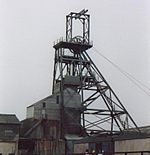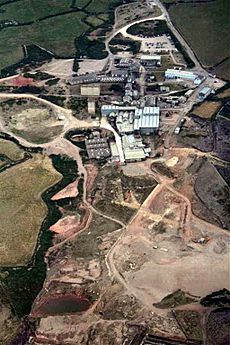Geevor Tin Mine facts for kids

The headgear over the Victory shaft
|
|
| Location | |
|---|---|
| Location | Pendeen |
| County | Cornwall |
| Country | England, United Kingdom |
| Coordinates | 50°09′09″N 005°40′33″W / 50.15250°N 5.67583°W |
| Production | |
| Products | Tin |
| History | |
| Opened | 1911 |
| Closed | 1990 |
| Owner | |
| Website | http://www.geevor.com/ |
| Type: | Cultural |
| Criteria: | ii, iii, iv |
| Designated: | 2006 (30th session) |
| Reference #: | 1512 |
| Region: | Europe and North America |
Geevor Tin Mine is a famous old tin mine in the far west of Cornwall, England. Its name comes from the Cornish language phrase Hwel an Gever, which means "mine of the goats." The mine was in operation from 1911 to 1990. During that time, miners brought up about 50,000 tons of black tin.
Today, Geevor is a museum and heritage center. It shows what life was like in a working tin mine. It is a special location on the European Route of Industrial Heritage. Since 2006, the mine has been a UNESCO World Heritage Site, as part of the Cornwall and West Devon Mining Landscape.
Contents
History of the Mine
People have been mining for tin and copper in the Geevor area since the late 1700s. At first, it was a small mine called Wheal an Giver, which means "a piece of ground occupied by goats."
Early Days
The mine was known as East Levant Mine until 1840. From 1851 to 1891, it was called North Levant before it closed down. In the 1880s, as many as 176 people worked there. But after it closed, only a few miners worked at the site from time to time.
A New Beginning
Around 1900, a group of miners from the town of St Just returned home from South Africa because of a war there. They rented the land and started looking for tin. They found enough to start a company called Levant North (Wheal Geevor) in 1901.
In 1911, a larger company bought the mine and named it Geevor Tin Mines Ltd. This happened after the price of tin went up, making mining profitable again.
The 20th Century
In 1909, miners began digging a new tunnel called the Wethered shaft. Later, the Victory shaft was added to celebrate the end of World War I. The mine had to close for a short time in 1921 and again in 1930 because of low tin prices.
After World War II, it was hard to find skilled miners. Geevor hired miners from Poland and Italy to help. In the 1960s, with new investment and rising tin prices, the mine grew. Workers even extended the tunnels under the sea to connect with the old Levant mine nearby.
Why Did the Mine Close?
By the 1970s, Geevor was a large operation. But in 1985, the price of tin suddenly dropped around the world. The mine tried to stay open but finally had to close in 1990. In 1991, the water pumps were turned off, and the deep tunnels slowly filled with water.
There is still tin in the ground at Geevor, but it would cost too much money to get it out. Over its life, the mine produced over 50,000 tons of tin and made a profit of over £7 million.
What Kind of Rocks are at Geevor?
The tin at Geevor was found in a type of rock called granite. This granite pushed its way up into the older, surrounding rocks millions of years ago. The local name for these older rocks is "killas."
The tin is found in a mineral called cassiterite. It appears in long veins, or cracks, in the rock. These veins also contain other minerals like quartz and tourmaline. The cassiterite itself made up only about 1% of the material in the veins.
Geevor as a Tourist Attraction
Thanks to the hard work of the local community and Cornwall County Council, Geevor Tin Mine is now a popular museum. It is the largest preserved tin mining site in Great Britain, covering 67 acres.
Visitors can explore the site and learn about Cornwall's mining history. A £3.8 million project, with help from the Heritage Lottery Fund, has made the museum even better.
What Can You Do at Geevor?
The Hard Rock Museum at Geevor tells the story of the mine and the people who worked there. You can see the original machinery and listen to recordings of former miners sharing their stories.
One of the most exciting parts of a visit is the guided underground tour. You can walk into Wheal Mexico, a mine tunnel that dates back to the 18th century. The site also has a gift shop and a café with views of the Atlantic Ocean. You can even try fun activities like panning for gold and gemstones.
See also
- List of topics related to Cornwall
- Mining in Cornwall and Devon
- Dartmoor tin-mining
- South Crofty
- Wheal Jane





